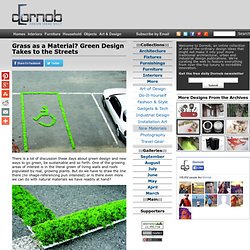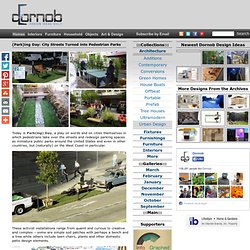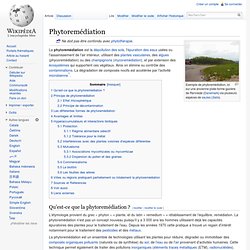

(Re)Make it Rain: Rainwater Reclamation Designs. Big, bulky plastic rain barrels have their place, but there’s more than one way to capture and store rainwater, as these 12 innovative and versatile designs and concepts prove. Dual-purpose garden furniture and rain cisterns, personal catchment systems that attach to water bottles, beautiful self-watering planters and towering public installations harvest the most precious resource of all, and they do it in style.
Rain Harvesting Garden Table (images via: green launches) Cisterns take up a lot of room, and not everyone has a huge backyard. This brilliant concept doubles the function by turning your rainwater reservoir into a garden table; the slanted surface of the table captures water. Downspouts Double as Water-Recycling Planters. Literal Lawn Chairs: Grass Sofas Brighten up British Summer. Summer means more time spent outdoors in the sun, but the National Trust of Great Britain found that British families are spending an average of 43 hours per week inside and on the sofa.

That’s a grand (or not-so-grand) total of 13 weeks per year. To get people out of the house and into nature, the National Trust has unveiled ten huge grass sofas in locations all across the UK. There are no TVs, no laptops – just unique spaces for quality outdoor family time. The massive furniture was grown in about a month using all natural materials: straw bases covered with blankets of green, growing grass.
These peculiar outdoor living rooms all consist of a sofa and a coffee table, letting British families get out of their homes but still spend time together in a familiar setting. The growing living rooms were placed in a handful of picturesque natural locations, with some even making appearances in town centers. GRASS COUCHES HIT THE STREETS OF SAN FRANCISCO Letsgreenthiscity, Green Sod Couches in San Francisco, Grass couches hit the streets of san francisco, Jen Siska, gavin newsome, readymade grass couch, readymade sod couch – Inhabitat - Green Design Will Save.
Grass as a Material? Green Design Takes to the Streets. There is a lot of discussion these days about green design and new ways to go green, be sustainable and so forth.

One of the growing areas of interest is in the literal green of living walls and roofs populated by real, growing plants. But do we have to draw the line there (no image-referencing pun intended) or is there even more we can do with natural materials we have readily at hand? While the environmental benefits of this particular application are tenuous it certainly has an aesthetic impact – a little added greenery to a parking lot, often the least green of all public spaces. However, this is just one application – an example showing the initial potential of something with great possibilities.
Of greater interest is the simple technology behind it – the roll-out material basis for the design strategy. (Park)ing Day: City Streets Turned into Pedestrian Parks. Today is Park(ing) Day, a play on words and on cities themselves in which pedestrians take over the streets and redesign parking spaces as miniature public parks around the United States and even in other countries, but (naturally) on the West Coast in particular.

These activist installations range from quaint and curious to creative and complex – some are simple sod patches with perhaps a bench and a tree while others include lawn chairs, plants and other domestic patio design elements. The idea is to promote civic engagement – to put the ‘public’ back into the idea of ‘public space’ through interactive, interesting and fun works of spatial design that anyone can do for a day. La dépollution des villes par des associations de plantes et micro-organismes.
Abonnement aux infos du site Recevez gratuitement nos dernières actualités par email.

La pollution de l’air, des sols et de l’eau est une réalité quotidienne à travers le monde. Les zones urbaines en sont un parfait exemple de part le nombre de sources d’émissions de polluants qu’elle concentre : trafic urbain, chauffage, activités industrielles… Les zones agricoles également : « L’IWMI (Institut international de gestion des ressources en eau) considère (…) que près de 20 millions d’hectares des exploitations agricoles du monde sont irrigués avec des eaux usées, même si cette pratique est en théorie interdite dans de nombreux pays. » (1). La santé humaine et le fonctionnement des écosystèmes se voient altérés au fur et à mesure que les pollutions s’accroissent. Phytoremédiation. Un article de Wikipédia, l'encyclopédie libre.

Exemple de phytoremédiation, ici sur une ancienne plate-forme gazière de Rønnede (Danemark) via plusieurs espèces de saules (Salix). La phytoremédiation est la dépollution des sols, l'épuration des eaux usées ou l'assainissement de l'air intérieur, utilisant des plantes vasculaires, des algues (phycoremédiation) ou des champignons (mycoremédiation), et par extension des écosystèmes qui supportent ces végétaux. Ainsi on élimine ou contrôle des contaminations. La dégradation de composés nocifs est accélérée par l'activité microbienne[1]. Qu'est-ce que la phytoremédiation ? L’étymologie provient du grec « phyton » = plante, et du latin « remedium » = rétablissement de l'équilibre, remédiation.
Dalle gazon RECYFIX GREEN SUPER par HAURATON France.